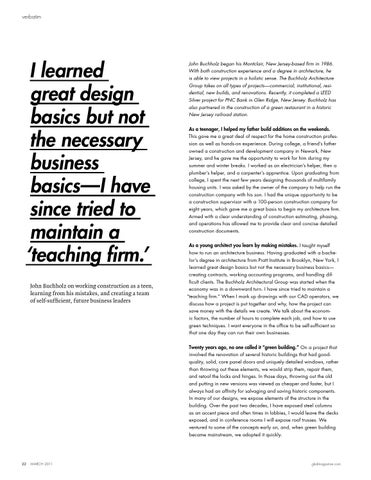verbatim
I learned great design basics but not the necessary business basics—I have since tried to maintain a ‘teaching firm.’ John Buchholz on working construction as a teen, learning from his mistakes, and creating a team of self-sufficient, future business leaders
John Buchholz began his Montclair, New Jersey-based firm in 1986. With both construction experience and a degree in architecture, he is able to view projects in a holistic sense. The Buchholz Architecture Group takes on all types of projects—commercial, institutional, residential, new builds, and renovations. Recently, it completed a LEED Silver project for PNC Bank in Glen Ridge, New Jersey. Buchholz has also partnered in the construction of a green restaurant in a historic New Jersey railroad station. As a teenager, I helped my father build additions on the weekends. This gave me a great deal of respect for the home construction profession as well as hands-on experience. During college, a friend’s father owned a construction and development company in Newark, New Jersey, and he gave me the opportunity to work for him during my summer and winter breaks. I worked as an electrician’s helper, then a plumber’s helper, and a carpenter’s apprentice. Upon graduating from college, I spent the next few years designing thousands of multifamily housing units. I was asked by the owner of the company to help run the construction company with his son. I had the unique opportunity to be a construction supervisor with a 100-person construction company for eight years, which gave me a great basis to begin my architecture firm. Armed with a clear understanding of construction estimating, phasing, and operations has allowed me to provide clear and concise detailed construction documents. As a young architect you learn by making mistakes. I taught myself how to run an architecture business. Having graduated with a bachelor’s degree in architecture from Pratt Institute in Brooklyn, New York, I learned great design basics but not the necessary business basics— creating contracts, working accounting programs, and handling difficult clients. The Buchholz Architectural Group was started when the economy was in a downward turn. I have since tried to maintain a “teaching firm.” When I mark up drawings with our CAD operators, we discuss how a project is put together and why, how the project can save money with the details we create. We talk about the economic factors, the number of hours to complete each job, and how to use green techniques. I want everyone in the office to be self-sufficient so that one day they can run their own businesses. Twenty years ago, no one called it “green building.” On a project that involved the renovation of several historic buildings that had goodquality, solid, core panel doors and uniquely detailed windows, rather than throwing out these elements, we would strip them, repair them, and retool the locks and hinges. In those days, throwing out the old and putting in new versions was viewed as cheaper and faster, but I always had an affinity for salvaging and saving historic components. In many of our designs, we expose elements of the structure in the building. Over the past two decades, I have exposed steel columns as an accent piece and often times in lobbies, I would leave the decks exposed, and in conference rooms I will expose roof trusses. We ventured to some of the concepts early on, and, when green building became mainstream, we adopted it quickly.
22
MARCH 2011
gbdmagazine.com
